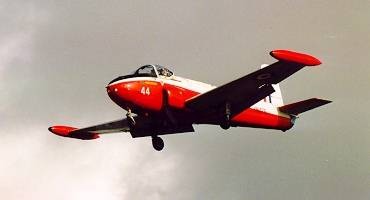|

Percival Jet Provost

Developed by Hunting from the
piston-engined Percival Provost basic trainer. Made in great numbers
for the RAF and many countries overseas. Developed again into the
Strikemaster multi-role trainer & attack version with more powerful
engines. Recently the remaining T.3A and T.5A airframes have been
replaced by the
Tucano in the RAF inventory. The Tucano uses eight times less
fuel than the Provost, and achieves similar performance figures. The
Provost has proved a rugged and reliable aircraft over many years.
Remaining examples are used for training of ground handling, notably
at RAF Cosford.
The T.3 was the first (and most numerous) Jet Provost. It was
equipped with the RR Viper 101 engine, unpressurized, had small tip
tanks and a low canopy which moved straight back. The T.4 was a
higher performance version with the bigger RR Viper 201 engine but
the same airframe, almost all of the T.4's are fatigued out (there
are perhaps 3 airworthy examples remaining). The T.5 was a
navigational/bomber trainer which used the RR 201 engine in a
redesigned airframe which was pressurized, had a large
upwards-sliding canopy, larger tip tanks and updated avionics. When
the T.4's fatigued out, they were replaced with the T-5A which was
like the T-5 but added modifications to improve aerobatic
performance, no tip tanks, spin strakes, roughened leading wing
edges, a slat above and a fence under the engine intakes. Another
derivative is the 167 Strikemaster, a ground attack airplane built
for export with the T-5 airframe, a 3500# engine, upgraded brakes
and armour. The "hot plane" of the lot is the 167 Strikemaster with
the armour removed.
TYPE
two seat basic trainer/ light strike aircraft
MANUFACTURER
Hunting/B.A.C. - British Aerospace.
ENGINE
(T.5) single Bristol Siddeley Viper 201 turbojet 2,500lb (1,134kg)
thrust
DIMENSIONS
- span : 36'10"(11.23m)
- length : 33'8.5"(10.27m)
- height : 10'11.5"(3.34m)
- wing area : 213.7sqft(19.79mē)
WEIGHTS
- empty : 4,658lb(2,100kg)
- loaded : 6,650lb(3,012kg)
- maximum : 7,300lb(3,306kg)
PERFORMANCE
- max speed at sea level :
390mph(627km/h)
- at 20,000' : 440mph(708km/h)
- ceiling : 44,000ft(13,410m)
- range : 600miles(967km)
FIRST FLIGHT
- prototype : 16th June 1954
- entered service as T.1 : August
1955
- followed by T.2, T.3, T.4, and
then T.5 on : 3rd September 1969
- Strikemaster : 1967
AVIONICS
- VOR VHF omnidirectional ranger
- ILS Instrument Landing System
- DME Distance Measuring Equipment
WEAPONS
- two 0.303" guns
- six 60lb or twelve 25lb rockets
- two 100lb or eight 25lb bombs
- maximum 3,000lb(1,360kg) on four
underwing strongpoints
|
